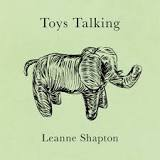| ________________
CM . . . . Volume XXIV Number 20 . . . . January 26, 2018
In size and shape, Toys Talking looks like a typical picturebook for the preschool crowd. And that impression is reinforced by the book's endpapers consisting of stuffed teddy bears and rabbits. And, if one looked only at the simple drawings of the 19 comforting "stuffies" that are rendered in black on coloured backgrounds on one of each pair of facing pages, the assumptions about the book's intended audience would likely remain the same. However, when adult mediators turn to the brief text that faces each illustration, they will question whether or not Toys Talking is actually a title for juveniles, especially the very young. Author Shapton has seemingly posed the question, "If these normally silent companions who witness virtually everything that occurs in a home could talk, what might they say?" The "words" out of the stuffies' mouths are quite mature and most definitely open to interpretation. For example, the opening pair of facing pages find a teddy bear accompanied by the text:
To whom is the teddy bear directing its statement (and why), or is it perhaps just repeating a portion of an overheard conversation? Later, a kangaroo stuffie, with a joey's head appearing from its pouch, says:
While a simple and straightforward statement, readers will want to know, "Who are the 'we' and the 'it', and why can't 'we' afford 'it'?" A stuffed rabbit states:
"How can inanimate objects have 'sleepless nights'," a reader might ask, among many other questions. In many ways, Shapton is inviting readers to "write/tell" their own stories about these 19 stuffies. As noted, each stuffie's brief statement calls for reader engagement, and, while Toys Talking may not be a first choice for the toddler crowd, I can certainly see it having a place in middle school language arts classes where, for example, the stuffed animals' words could serve as writing prompts calling for students to adopt the point of view of the inanimate toy and flesh out the circumstances that led to what it said. Recommended with Reservations. Dave Jenkinson, CM's editor, lives in Winnipeg, MB.
Next Review |
Table of Contents for This Issue
- January 26, 2018. |
